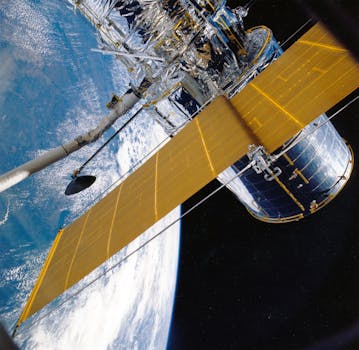
The Rise of Mega-Constellations: Latest Updates in Satellite Telecommunications
The Rise of Mega-Constellations: Latest Updates in Satellite Telecommunications. The rise of mega-constellations is revolutionizing the field of satellite telecommunications, with thousands of small satellites being launched into low Earth orbit to provide global internet coverage. This new era of space technology is transforming the way we communicate, access information, and conduct business.
Mega-constellations are fleets of satellites that work together to provide a range of services, including internet connectivity, navigation, and Earth observation. These constellations are typically composed of hundreds or thousands of small satellites, each weighing less than 500 kilograms, which are launched into low Earth orbit (LEO) at an altitude of around 500-1,200 kilometers. The satellites are designed to be highly efficient and cost-effective, with a lifespan of around 5-7 years.
The development of mega-constellations is driven by the growing demand for global internet coverage, particularly in remote and underserved areas. Traditional satellite systems have limitations in terms of coverage, capacity, and latency, which can make them unsuitable for applications that require high-speed and low-latency connectivity. Mega-constellations, on the other hand, offer a number of advantages, including global coverage, high capacity, and low latency.
Benefits of Mega-Constellations
The benefits of mega-constellations are numerous. One of the most significant advantages is the ability to provide global internet coverage, including in areas where traditional telecommunications infrastructure is lacking. This can help to bridge the digital divide and provide access to information and services for millions of people around the world.
Mega-constellations can also provide a range of other benefits, including improved navigation, Earth observation, and disaster response. For example, satellite constellations can be used to track weather patterns, monitor climate change, and detect natural disasters such as earthquakes and hurricanes. They can also be used to provide critical infrastructure for emergency response, such as search and rescue operations.
In addition to these benefits, mega-constellations are also driving innovation in the field of space technology. The development of small satellites and reusable launch vehicles is reducing the cost of access to space and enabling new types of missions and applications. This is creating new opportunities for startups and entrepreneurs, as well as established companies and governments.
Challenges and Concerns
While the rise of mega-constellations is an exciting development, there are also challenges and concerns that need to be addressed. One of the most significant concerns is the risk of space debris, which can pose a hazard to other satellites and spacecraft in Earth’s orbit. The launch of thousands of small satellites into LEO is increasing the risk of collisions and the creation of new debris.
Another concern is the impact of mega-constellations on the night sky and astronomical research. The brightness of the satellites can interfere with astronomical observations and disrupt the natural darkness of the night sky. This is a concern for astronomers and stargazers, as well as for the general public who value the beauty and wonder of the night sky.
There are also concerns about the regulatory framework for mega-constellations. The launch and operation of thousands of satellites require a range of permits and approvals, as well as compliance with international regulations and standards. The regulatory framework is still evolving, and there is a need for greater clarity and consistency to ensure that the benefits of mega-constellations are realized while minimizing the risks and negative impacts.
Latest Updates and Developments
There have been a number of recent developments and updates in the field of mega-constellations. One of the most significant is the launch of SpaceX’s Starlink constellation, which aims to provide global internet coverage with a fleet of thousands of small satellites. Other companies, such as Amazon’s Kuiper Systems and OneWeb, are also developing their own constellations and launching satellites into LEO.
There have also been advances in the development of small satellites and reusable launch vehicles. Companies such as Rocket Lab and Relativity Space are pushing the boundaries of what is possible with small satellites, while reusable launch vehicles such as SpaceX’s Falcon 9 and Blue Origin’s New Glenn are reducing the cost of access to space.
In addition to these developments, there is also a growing focus on the sustainability and environmental impact of mega-constellations. Companies and governments are recognizing the need to minimize the risk of space debris and to develop sustainable practices for the launch and operation of satellites. This includes the development of new technologies and materials, as well as the implementation of responsible practices for the disposal of satellites at the end of their life.



